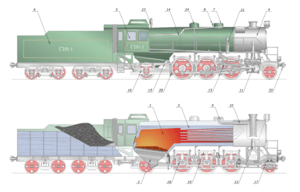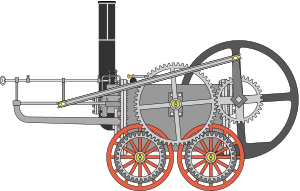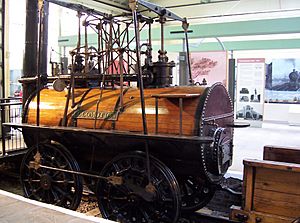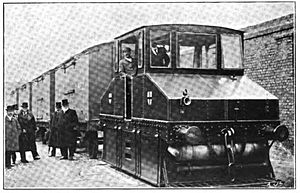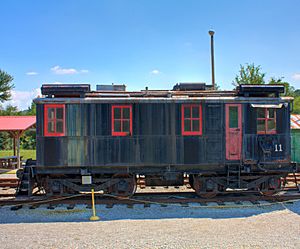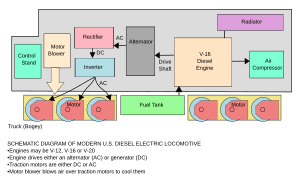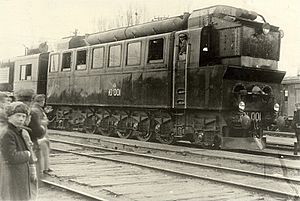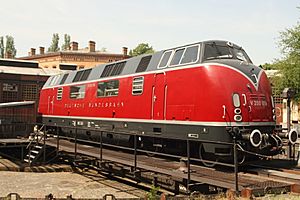Locomotive facts for kids
A locomotive or engine is a special vehicle used in rail transport. Its main job is to provide the power that moves a train. If a vehicle can carry passengers or cargo *and* move itself, it's usually called a multiple unit, railcar, or power car. These self-powered vehicles are common for passenger trains but not so much for cargo trains.
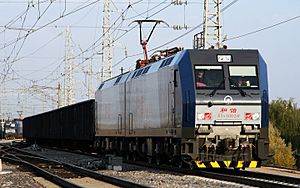
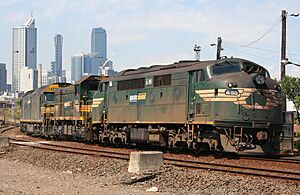
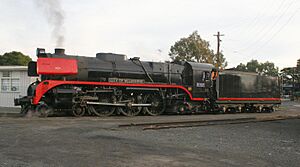
Usually, locomotives pull trains from the front. But now, it's common for trains to have locomotives at the front, back, or both ends. This is called push-pull operation.
Contents
What Does "Locomotive" Mean?
The word "locomotive" comes from Latin. "Loco" means "from a place," and "motivus" means "causing motion." It's a shorter way of saying "locomotive engine." This term was first used in 1814 to tell the difference between engines that could move and those that stayed in one place.
How Locomotives Are Classified
Before locomotives, trains were moved by people, horses, gravity, or stationary engines that pulled cables. Very few of these old systems are still used today.
How Locomotives Get Power
Locomotives can get their power from burning fuel like wood, coal, oil, or natural gas. They can also get electricity from an outside source. We often classify locomotives by where their energy comes from. Here are the common types:
Steam Locomotives
A steam locomotive uses a steam engine as its main power source. Most steam locomotives have a large boiler that heats water to create steam. This steam is made by burning fuel, usually coal, wood, or oil. The steam then pushes pistons, which are connected to the locomotive's main wheels, called "drivers." The locomotive carries its fuel and water, either on board or in special wagons called "tenders" pulled behind it.
The first working steam locomotive was built by Richard Trevithick in 1802. On February 21, 1804, another of Trevithick's locomotives made the first recorded steam-powered train journey in South Wales. This design was important because it used high-pressure steam, which made the engine lighter and more efficient.
In 1812, Matthew Murray's Salamanca was a successful early steam locomotive. Another famous one was Puffing Billy, built in 1813–14. George Stephenson built Locomotion No. 1 for the Stockton and Darlington Railway, the world's first public steam railway. In 1829, his son Robert built The Rocket, which won the Rainhill Trials. This made their company a top builder of steam locomotives.
Steam locomotives were the most common type until after World War II. Electric and later diesel-electric locomotives started to replace them. By the 1950s, steam power was mostly gone in North America. In Europe, electric power replaced steam by the 1970s. Steam locomotives were less efficient and needed more people to operate and maintain them compared to modern diesel and electric ones.
Kerosene Locomotives
A kerosene locomotive uses a kerosene-powered internal combustion engine. These were the first oil-powered locomotives, built before diesel engines. The first kerosene locomotive was built in 1894 for the Hull docks in England. It wasn't very powerful. The first successful one, "Lachesis," was built in 1896 for the British military.
Petrol Locomotives
A petrol (gasoline) locomotive also uses an internal combustion engine. These engines need a special transmission to send power to the wheels. The engine must keep running even when the locomotive stops.
Most petrol locomotives used a mechanical transmission. The first successful commercial petrol locomotive was built by the Maudslay Motor Company in 1902 for a cattle market in London. During World War I, small Simplex petrol locomotives were used on trench railways.
Diesel Locomotives
A diesel locomotive uses a diesel engine. Like petrol engines, diesel engines need a transmission to power the wheels and must keep running when stopped. Early diesel locomotives used different systems, but electric transmission became the most popular. Most diesel locomotives today are diesel-electric.
Diesel-Mechanical Locomotives
A diesel-mechanical locomotive uses a mechanical transmission to send power to the wheels. This type is usually for smaller, slower locomotives used for shunting (moving wagons around a yard) or for lightweight railcars. The very first diesel locomotives were diesel-mechanical.
The mechanical transmissions in these locomotives are more complex and stronger than those in cars. They often use special gears that allow shifting while the train is moving. Building a mechanical transmission strong enough for a heavy train is difficult, which limits their use. The world's first diesel-powered locomotive ran in Switzerland in 1912 but wasn't a commercial success.
Diesel-Electric Locomotives
In a diesel-electric locomotive, the diesel engine doesn't directly power the wheels. Instead, it drives an electrical generator or alternator. This generator produces electricity, which then powers electric motors called traction motors that turn the wheels. There is no mechanical link between the diesel engine and the wheels. Most diesel locomotives today are diesel-electric.
The main parts are the diesel engine, the generator, the traction motors, and a control system. Originally, the motors and generator used DC electricity. Later, in the 1960s, generators were replaced by alternators that converted their output to DC. This made locomotives more reliable. In the late 1980s, new technology allowed the use of AC traction motors, which are even more efficient and reliable.
In 1914, Hermann Lemp developed a reliable electrical control system for diesel-electric locomotives. This design became the model for all future diesel-electric controls. In 1924, the SŽD Eel2, designed by Yuri Lomonosov, started operating. It was the world's first truly functional diesel locomotive.
Diesel-Hydraulic Locomotives
Diesel-hydraulic locomotives use special fluid-filled devices called torque converters, along with gears, to send power from the diesel engine to the wheels.
A torque converter uses oil to transfer power. To work well at different speeds, these locomotives might use several torque converters or a mechanical gearbox after the converter. They can switch between these smoothly, even while moving.
Germany was a major user of main-line hydraulic transmissions. British Rail also used some diesel-hydraulic designs. These systems are mostly used for low-speed shunting or railway maintenance vehicles today.
Diesel-Steam Locomotives
Steam-diesel hybrid locomotives can use either steam from a boiler or a diesel engine to power a piston engine. One system used a diesel engine to power a compressor, which then drove and recirculated steam.
In the 1940s, diesel locomotives began replacing steam locomotives in America. After World War II, diesel power spread to many countries. This shift, called Dieselization, happened because diesel locomotives were much cheaper to run. By the late 1990s, steam locomotives were mostly only found on heritage railways.
Diesel locomotives need much less maintenance than steam engines. A steam locomotive might spend several days a month in the shop, while a diesel locomotive needs only about eight to ten hours of maintenance per month. Diesel units also pollute less than steam trains.
Gas Turbine Locomotives
A gas turbine locomotive uses a gas turbine engine. Like other internal combustion engines, it needs a transmission to power the wheels and must keep running when stopped.
Gas turbine-mechanical locomotives use a mechanical transmission. The first patent for a gas turbine locomotive was in 1861. In 1952, Renault built a prototype gas turbine-mechanical locomotive.
Gas turbine-electric locomotives use a gas turbine to drive an electrical generator, which then powers electric motors that turn the wheels. The first gas turbine-electric locomotive was built in 1941 for the Swiss Federal Railways. Union Pacific Railroad in the US used a large fleet of these locomotives in the 1950s for long-distance freight. They were cost-effective because they could use cheaper "leftover" fuels.
Gas turbines have fewer moving parts than piston engines, which can mean less maintenance. They also have a higher power-to-weight ratio, meaning they can be very powerful without being huge. However, their power and efficiency drop a lot at lower speeds, making them best for long, high-speed journeys. They were also very noisy and produced extremely hot exhaust.
Electric Locomotives
An electric locomotive is powered only by electricity. Trains get electricity from a conductor running along the track. This can be an overhead line (wires above the track), a third rail (a rail at track level), or an onboard battery. Both overhead wire and third-rail systems usually use the regular rails to complete the electrical circuit.
Trains collect electricity using different devices: a trolley pole (a long flexible pole), a bow collector (a frame holding a rod), a pantograph (a hinged frame), or a contact shoe (for third rails). Pantographs are best for high-speed trains.
Electric locomotives almost always have electric motors attached directly to their axles, one motor for each powered axle. These motors turn the wheels using gears. The gear ratio depends on what the locomotive is used for. High ratios are common for freight trains, while lower ratios are for passenger trains.
Electricity for trains is usually made in large power stations. It's then sent to the railway network and distributed to the trains. Some railways have their own power stations, but most buy electricity from utility companies.
Direct Current (DC) Systems
The earliest electric train systems used DC. The first electric passenger train was shown by Werner von Siemens in Berlin in 1879. It carried 90,000 passengers on a short track. The electricity (150 V DC) came from a third rail. The world's first electric tram line opened near Berlin in 1881.
The first electric underground railway was the City and South London Railway, which opened in 1890. Electricity quickly became the preferred power for subways. The first use of electrification on a main line was in 1895 on the Baltimore and Ohio Railroad in the US.
DC systems were used early on but were gradually replaced by AC. Today, most main-line railways use AC. DC systems are mainly for urban transit like metros, light rail, and trams, where less power is needed.
Alternating Current (AC) Systems
The first practical AC electric locomotive was designed by Charles Brown in Switzerland. In 1891, Brown showed how to transmit power long distances using three-phase AC. He realized that three-phase AC motors were more powerful for their size and simpler to build than DC motors.
In 1894, Hungarian engineer Kálmán Kandó developed new three-phase AC motors for locomotives. His designs were first used on a tramway in France in 1896. In 1918, Kandó invented a way for electric locomotives to use three-phase motors with just a single overhead wire, using standard industrial frequency AC.
In 1896, the first commercial AC system was installed on the Lugano Tramway. In 1899, the first main-line three-phase locomotives were used in Switzerland. The first use of industrial frequency single-phase AC for locomotives was in 1901 in Switzerland.
Italian railways were the first in the world to electrify an entire main line. The 106 km Valtellina line opened in 1902, designed by Kandó. It used a higher voltage (3 kV 15 Hz) than before, which required new designs. This "Italian system" was used on several railways in Northern Italy.
Battery-Electric Locomotives
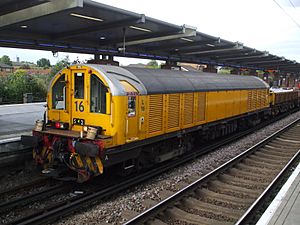
A battery-electric locomotive is an electric locomotive powered by batteries on board.
These locomotives are used when regular diesel or electric locomotives aren't suitable. For example, they're used for maintenance trains on electrified lines when the power is turned off. They are also used in industrial places or mines where fumes, fire, or explosions from combustion engines could be dangerous.
The first known electric locomotive was built in 1837 by Robert Davidson and powered by batteries. He later built a larger one called Galvani in 1841. It could pull six tons at 6 kilometers per hour. However, the limited power from batteries prevented them from being widely used.
Later, battery locomotives were used in places like the Kennecott Copper Mine in Alaska. The Toronto Transit Commission and London Underground have also used battery-electric locomotives for maintenance work.
How Locomotives Are Used
Locomotives are often grouped by what they are used for in railway operations. There are:
- passenger locomotives (for passenger trains)
- freight locomotives (for cargo trains)
- switcher or shunting locomotives (for moving wagons in yards)
Images for kids
-
A China Railways HXD1D electric locomotive in China.
-
Wainwright SECR Class P on the Bluebell Railway, England.
-
Bombardier ALP-45DP at the Innotrans convention in Berlin.
See also
 In Spanish: Locomotora para niños
In Spanish: Locomotora para niños


